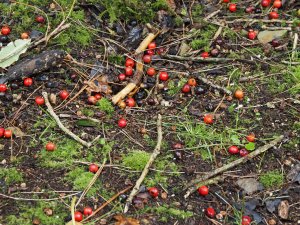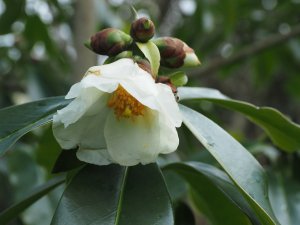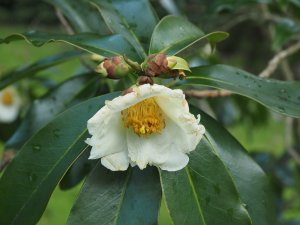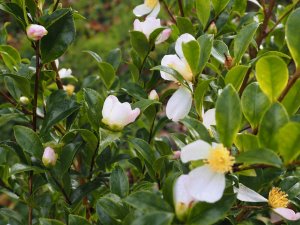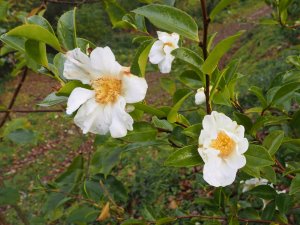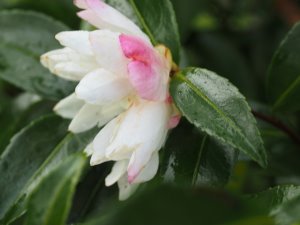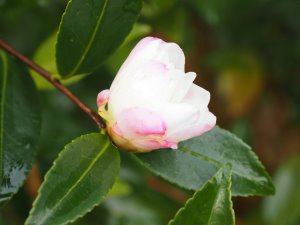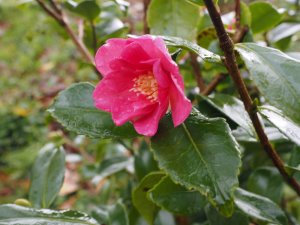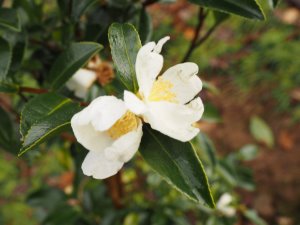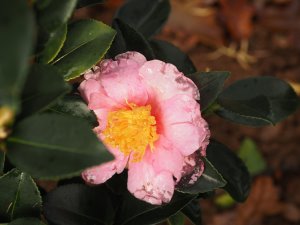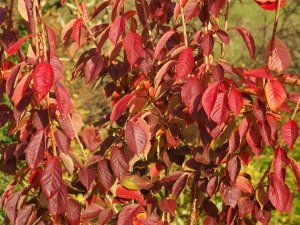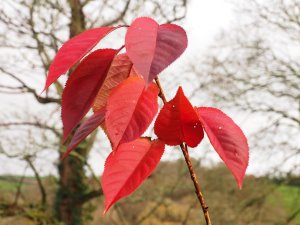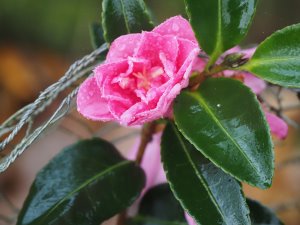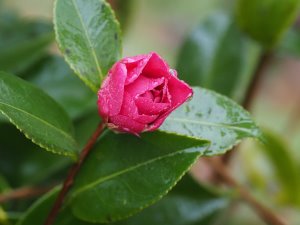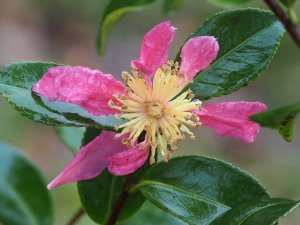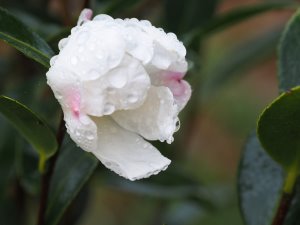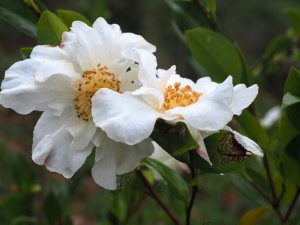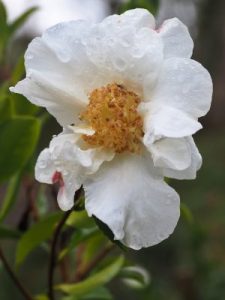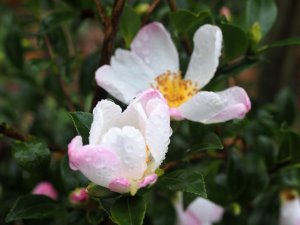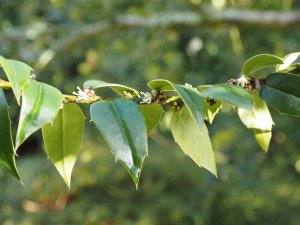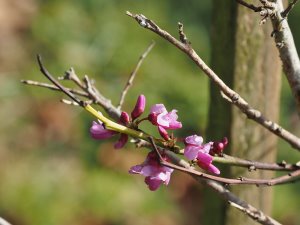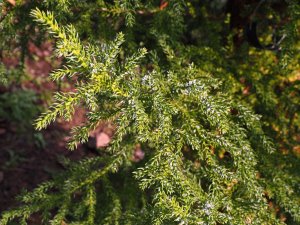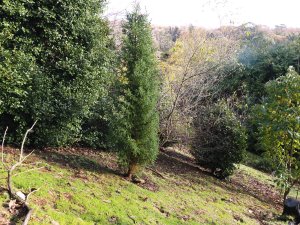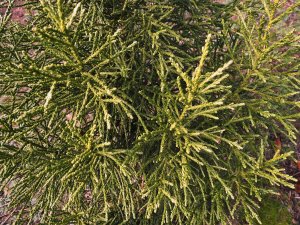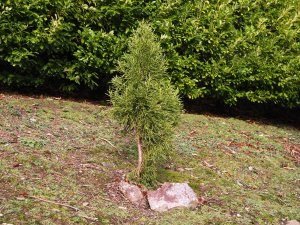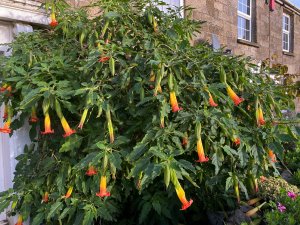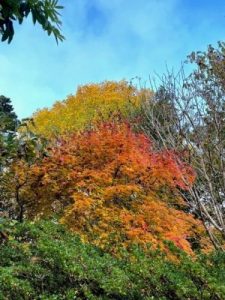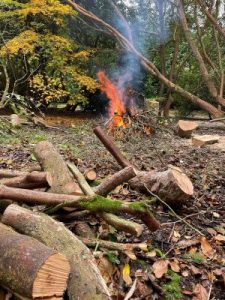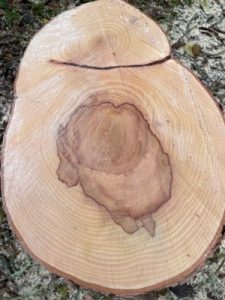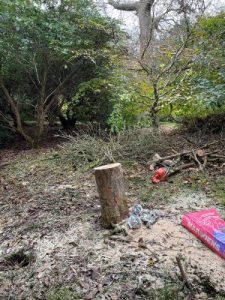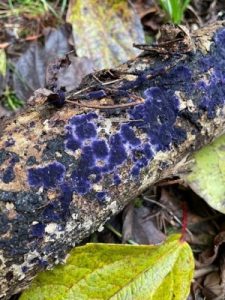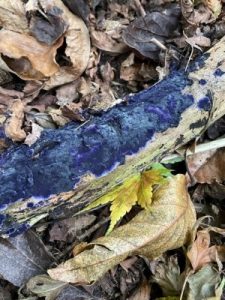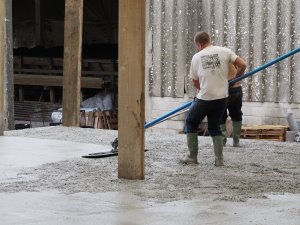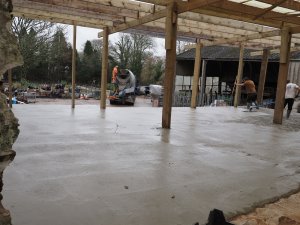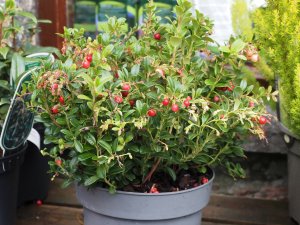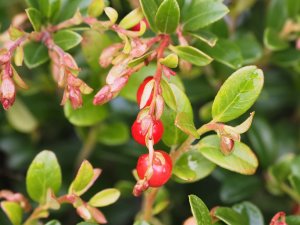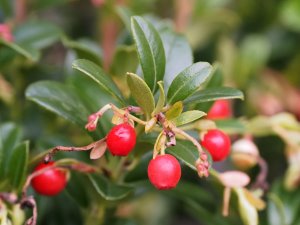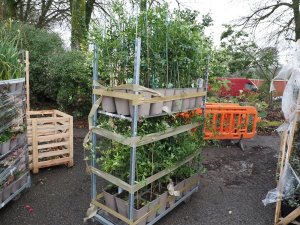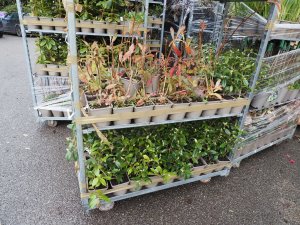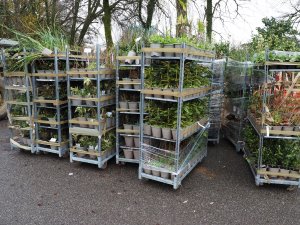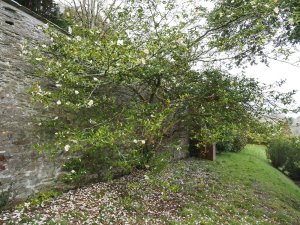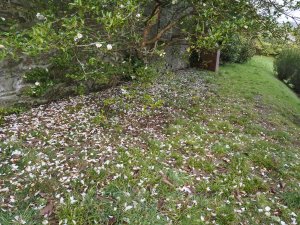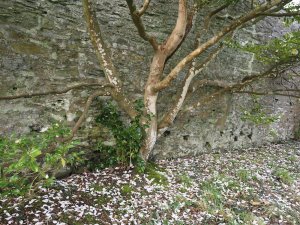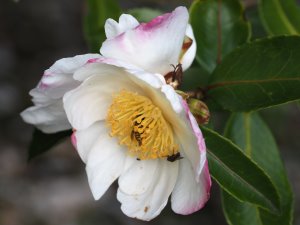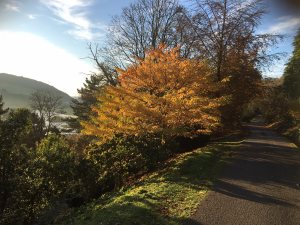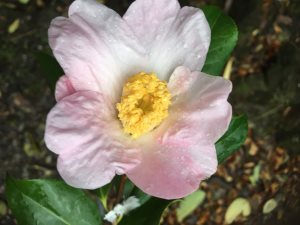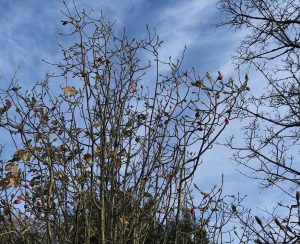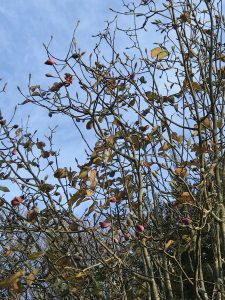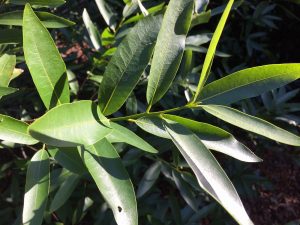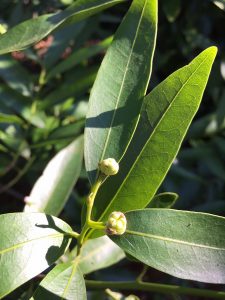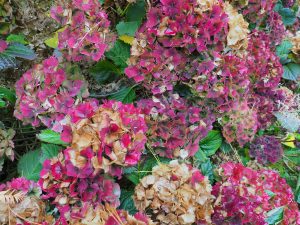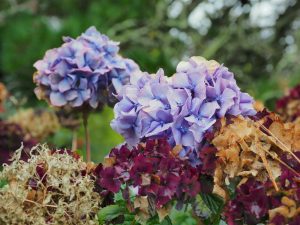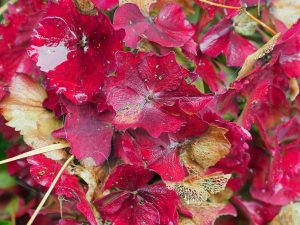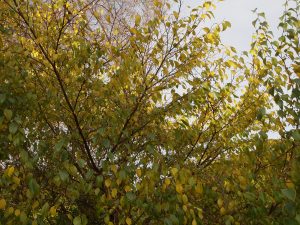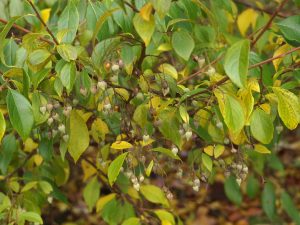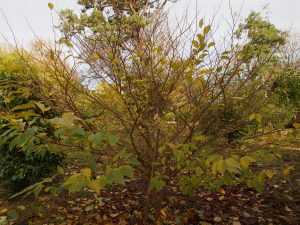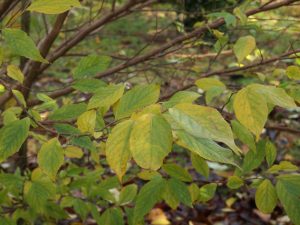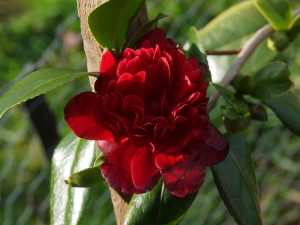2025 – CHW
Tilia endochrysea still full of leaf.
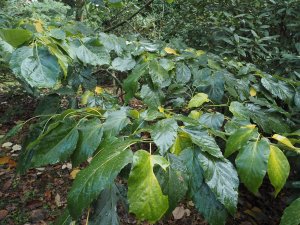
Fallen berries under Ilex latifolia.
Polyspora longicarpa with its second flush of flowers.
2024 – CHW
The first of the 5 ancient Camellia sasanqua to flower lost all its last flowers in the recent gales and rain.
The first of the 5 ancient Camellia sasanqua to flower lost all its last flowers in the recent gales and rain.
Camellia sasanqua ‘Versicolor’ performing well in the Beatrice Fleur Plantation.
Camellia sasanqua ‘Setsugekka’.
Camellia sasanqua ‘Blush’.
Camellia sasanqua ‘Sekiyo’ is a new one to us and a good red.
Camellia sasanqua ‘Survivor’ which I think we are seeing for the first time in flower here.
Camellia sasanqua ‘Pink Goddess’ is newly planted and a good large flower.
Prunus ‘Beni-yutaka’ is the best coloured of any of the 24 Matsumae cherries below White Styles.
2023 – CHW
Another visit to the young Camellia sasanqua planting at the entrance to Old Park. Still only a quarter of the varieties out in flower as yet but many others well budded.Young magnolias with autumn colour moments.Camellia sasanqua ‘Manhattan Pink’.
Another visit to the young Camellia sasanqua planting at the entrance to Old Park. Still only a quarter of the varieties out in flower as yet but many others well budded.Young magnolias with autumn colour moments.Camellia sasanqua ‘Manhattan Pink’.
Camellia sasanqua ‘Elfin Rose’
Camellia sasanqua ‘Sekiyo’.
Camellia sasanqua ‘Survivor’ – this one not listed in the new CSI book on sasanquas.
Camellia sasanqua ‘Setsugekka’ – this is clearly one of the best new ones with large flowers.
Camellia sasanqua ‘Versicolor’ – delicate and nice.
2022 – CHW
Ilex bioritsensis above the greenhouse is covered in, now shedding, flower. The reference books deny it is autumn flowering. The flowers carpet the steps above the main greenhouse.
Ilex bioritsensis above the greenhouse is covered in, now shedding, flower. The reference books deny it is autumn flowering. The flowers carpet the steps above the main greenhouse.
Malus x micromalus with (as usual) developing small yellowish fruits. Each one coated in water in the sun. The fruits will stay on the bush until early spring and enlarge a bit more. The birds ignore them.
A rogue secondary flower on Cercis chinensis ‘Avondale’ in the Isla Rose plantations. A bizarre find!
Athrotaxis selaginoides growing well below Sinogrande Walk. Planted 2009. Erect habit and a Tasmanian native.
Athrotaxis cupressoides also growing well above Sinogrande Walk (but not on the planting plans as yet?) I need to check but I think we have the third species, Athrotaxis laxifolia elsewhere. There are only 3 known species of this rare conifer, all from Tasmania.
2021 – CHW
Steve Dance stopped in Leedstown to photograph this extraordinarily large Datura sanguinea growing outside in someone’s garden. Leedstown is on top of a hill at the edge of the Lizard Peninsula but still clearly mild enough for this conservatory plant to do exceptionally well.
Steve Dance stopped in Leedstown to photograph this extraordinarily large Datura sanguinea growing outside in someone’s garden. Leedstown is on top of a hill at the edge of the Lizard Peninsula but still clearly mild enough for this conservatory plant to do exceptionally well.
Autumn colours on an acer and the Liriodendron chinense below Slip Rail.
A big bonfire in the gardens today clearing a large dead Rhododendron ‘Red Admiral’ which was planted below Slip Rail some 50 to 60 years ago as part of a clump. The tree rings show very different growth rates in different years.
This is, I think, a rotting example of common grey disco – Mollisia cinerea – which grows on rotting wood of deciduous trees.
2020 – CHW
Pouring concrete onto the base of the new covered area by the main packing shed at Burncoose.
Pouring concrete onto the base of the new covered area by the main packing shed at Burncoose.
Vaccinum vitis-idaea ‘Fireballs’ is new to us and I presume for the new catalogue. A flower or two still and plenty of red berries.
Twenty full trolleys of plants bought from Lanhydrock nursery as it closed. A fine trolley of banksian roses and a good pile of camellias and small deciduous azaleas.
A communication from Owen Johnson, the senior tree recorder for record trees:
After seeing the video about Camellia sasanqua at Caerhays, Owen Johnson sends this message:
Charles might be interested in two tree-sized Camellia sasanqua at Saumarez Park on Guernsey (now a public park). In September 2006 I was shown round by the island’s tree-measurer Robin Waterman who told me they were ‘Narumigata’ – I seem to remember flowers on them already – and had been described as ‘good, big bushes’ in 1903. Perhaps they came from the local Caledonia Nursery which operated from the 1850s, rather than via Veitch. (Unfortunately I don’t have Robin’s email for quickly checking his source with him.) But Saumarez Park isn’t quite in England anyway!
Hoping to find out more about this nursery in this regard and that maybe, it might make a connection with the large plant of this variety that Caroline tells me is at Caerhays, Charles. Here are pictures of the elderly Camellia sasanqua ‘Narumigata’ growing here on the top wall above the front door.
After seeing the video about Camellia sasanqua at Caerhays, Owen Johnson sends this message:
Charles might be interested in two tree-sized Camellia sasanqua at Saumarez Park on Guernsey (now a public park). In September 2006 I was shown round by the island’s tree-measurer Robin Waterman who told me they were ‘Narumigata’ – I seem to remember flowers on them already – and had been described as ‘good, big bushes’ in 1903. Perhaps they came from the local Caledonia Nursery which operated from the 1850s, rather than via Veitch. (Unfortunately I don’t have Robin’s email for quickly checking his source with him.) But Saumarez Park isn’t quite in England anyway!
Hoping to find out more about this nursery in this regard and that maybe, it might make a connection with the large plant of this variety that Caroline tells me is at Caerhays, Charles. Here are pictures of the elderly Camellia sasanqua ‘Narumigata’ growing here on the top wall above the front door.
2019 – CHW
Jaimie caught this picture of Cornus controversa with the last of its full yellow autumn display. This is a self-sown seedling of the nearby elderly Cornus which we had believed was Cornus bretschneideri but Hillier’s recently disputed this and said it was C. controversa when we supplied them with another self-sown seedling. I remain a little unconvinced. All blown away now anyway.
Jaimie caught this picture of Cornus controversa with the last of its full yellow autumn display. This is a self-sown seedling of the nearby elderly Cornus which we had believed was Cornus bretschneideri but Hillier’s recently disputed this and said it was C. controversa when we supplied them with another self-sown seedling. I remain a little unconvinced. All blown away now anyway.
The first fully open flower on Camellia x williamsii ‘JC Williams’ beside the Rockery. Compare this to last year and very similar timing. ‘St Ewe’ has, in recent years, been out a month or so earlier than ‘JCW’ but ‘November Pink’ normally wins the race to be the first named x williamsii out in flower.
2018 – CHW
Horror of horrors the Magnolia campbellii seedling below the main path is bursting into flower. Frost today so that will be the end of the flowers. After the ‘Beast from the East’ one might have hoped that they had learnt their lesson about flowering early! It has not been that mild an autumn by recent standards with a few frosty snaps and the recent blast of easterly winds. Hopefully no more magnolias will try to jump the gun. On reflection perhaps this is some sort of record?
Horror of horrors the Magnolia campbellii seedling below the main path is bursting into flower. Frost today so that will be the end of the flowers. After the ‘Beast from the East’ one might have hoped that they had learnt their lesson about flowering early! It has not been that mild an autumn by recent standards with a few frosty snaps and the recent blast of easterly winds. Hopefully no more magnolias will try to jump the gun. On reflection perhaps this is some sort of record?
Umbellularia californica is also coming into flower. Hillier’s says it flowers in April so another plant being fooled by the seasons. Perhaps the very dry summer? The ground is still pretty dry today.
2017 – CHW
It is amazing how a blue hydrangea can turn and fade into such extraordinary dark colour. Mainly dark red but with some greens. Three blue flowers still remain at the top of the bush.
It is amazing how a blue hydrangea can turn and fade into such extraordinary dark colour. Mainly dark red but with some greens. Three blue flowers still remain at the top of the bush.
2016 – CHW
Off to check autumn colour on the main styrax species planting which proved to be a dead loss as most are still entirely green today.Styrax formosanus var formosanus is just turning yellow and the seeds are now ripe and starting to fall.
Off to check autumn colour on the main styrax species planting which proved to be a dead loss as most are still entirely green today.Styrax formosanus var formosanus is just turning yellow and the seeds are now ripe and starting to fall.
Styrax faberi has largely fallen but there was little, if any, colour before they all did as you can see. Seed long gone and fallen here.
A surprise Camellia ‘Takinini’ with just one rather battered double reddish flower. A plant only put in this year in a very open place.
Camellia x williamsii ‘George Blandford’ has one flower out but too high up to photograph. Camellia ‘Caerhays’ not out yet.
2015 – CHWFuchsias still in full leaf and flower beside the gents’ loo.
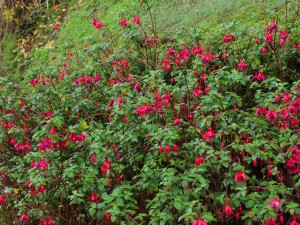
1998 – FJW
Many flowers on Camellia November Pink – very wet year continues – heavy rain but worse in Wales.
1971 – FJW
First November Pink in house. Leaf still on Beech Walk oaks. A very dry autumn.
1916 – JCW
Erica hybrida and Erica codonodes are opening. C sasanqua is fair. Have picked a good deal of rhodo and azalea seed but some is not ripe yet such as Mrs J.C. Williams and Azalea viscosum, just the worst weeks for rhodo flowers.




